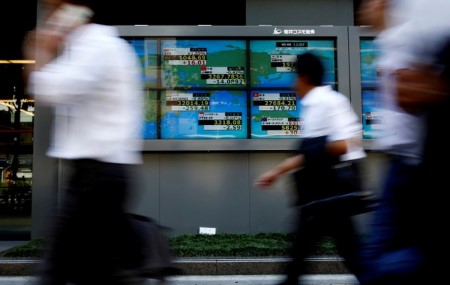




Policy Rate Updates: Double cut finale
 DOWNLOAD
DOWNLOAD

Monthly Economic Update: One for the road
 DOWNLOAD
DOWNLOAD

Inflation Update: Still low, still slow
 DOWNLOAD
DOWNLOAD


Bank of Korea next up, Nvidia keeps on rollin’

Asian markets could be delicately poised at the open on Thursday, with growing worries over how soon US and global interest rates will come down offset by a potential boost from AI and chip-making giant Nvidia’s earnings late on Wednesday.
Nvidia shares jumped as much as 5% in after-hours trading immediately after its first-quarter results were published, but quickly gave back a chunk of that in choppy trading. US futures turned negative, pointing to a lower open on Thursday.
Nvidia reported stronger-than-expected Q1 earnings, forecast Q2 revenues above estimates, and announced a ten-for-one forward stock split effective June 7.
If investors decide they like what they see from Nvidia’s results and earnings call, a brighter trading day on Thursday beckons.
In Asia, the calendar is dominated by a Bank of Korea policy decision, PMIs from Australia and India, inflation figures from Singapore and Hong Kong, and Singapore’s Q1 GDP.
The Bank of Korea is expected to keep its key policy rate unchanged at 3.50% for an 11th straight meeting, a Reuters poll showed, then cut by 50 basis points in the fourth quarter after the likely start of policy easing from global peers.
Trading in Japanese bonds and the yen is stirring again, which is likely to cause Bank of Japan officials some degree of discomfort – the yen is weakening even though yields are rising.
The 10-year JGB yield hit 1.00% on Wednesday for the first time in 11 years amid mounting bets for further BOJ policy tightening this year, while a weak auction of 40-year debt added to the pressure for higher yields.
The two-year yield printed a fresh 15-year peak of 0.35%.
Yet the yen fell, nearing 157.00 against the US dollar and printing a 17-year high against the New Zealand dollar after the Reserve Bank of New Zealand struck a surprisingly hawkish tone in keeping interest rates on hold.
US bond yields are also ticking higher too, after minutes of the Fed’s last policy meeting released on Wednesday showed that officials still expect inflation to return to their 2% target over the medium term, but “the disinflation would likely take longer than previously thought.”
Goldman Sachs CEO David Solomon joined the small but growing band that thinks the Fed won’t cut rates at all this year.
Meanwhile, the US-China trade war will start hitting the headlines ahead of the G7 meeting in Italy later this week, where officials will push back on China’s growing export strength in key sectors.
The United States is not calling on its partners to slap tariffs on Chinese imports, but will want the G7 communique to express common concern for what it calls Beijing’s industrial “overcapacity”.
Here are key developments that could provide more direction to markets on Wednesday:
– South Korea monetary policy decision
– Singapore, Hong Kong CPI inflation (April)
– Japan, Australia, India PMIs (May)
(Reporting by Jamie McGeever; Editing by Josie Kao)
This article originally appeared on reuters.com





 By Reuters
By Reuters